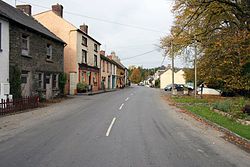Clonegal
| Clonegal Irish: Cluain na nGall | |
| County Carlow | |
|---|---|

| |
| Location | |
| Grid reference: | S916607 |
| Location: | 52°41’26"N, 6°38’43"W |
| Data | |
| Population: | 280 (2006) |
| Local Government | |
Clonegal, otherwise written Clonegall is a village in the southeast of County Carlow, in a rural setting, three mils from Bunclody (across in County Wexford) and 14 miles from Carlow Town.
The village stands just over a mile north of where the River Slaney and the River Derry meet. Clonegal has a much smaller "twin" village across the River Derry in County Wexford, Watch House Village.
The town is served by a primary school, and is central to a thriving agricultural hinterland, although it has little business development. Further housing development is imminent.
Name
The name 'Clonegal' comes from the Irish Cluain na nGall, meaning 'Meadow of the Foreigner'.[1] The reason for the name is unknown. Some contend that it came from foreign students who came to study in a monastery near the village. The romantic, or gruesome imagination has it that during the Irish Confederate Wars Cromwell's men fought the Irish in the village in 1650 after which all Irish surviving males were massacred.
History
It once had eleven malt houses in and around the village, along with a wool and corn store, a police station and other shops.
Places of interest
- Huntington Castle (also known as Clonegal Castle) was built on the site of an old manor house by the Esmonds in 1625. It is one of the few castles still lived in by direct descendants of the builder. In 1588 Queen Elizabeth I’s forces had captured the area and it was given to the Netterville family who in turn gave it to the Esmonds.

- St Brigid’s Church - the present church replaced the old Roman Catholic church which was built of mud walls and had a thatched roof. It is a barn type construction, built in 1824 around the old church. When the new building was completed the old building was taken out through the doors of the new church.
- St Fiaacs Church is a Church of Ireland church situated on a slope to the north of the village. It was founded about the time of Saint Patrick on a Dun surrounded by a deep moat enclosed by a rath, and was believed to have been the residence of an ancient chieftain in the 6th century.
- The Old Rectory is now a private house, but was the residence of John DeRenzy, commander of the yeomen in Clonegal during the Irish Rebellion of 1798. Prisoners to be hanged were brought to a yard just above the rectory. The archway leading into this yard is known as the Hanging Arch and is marked by a stone slab on the wall.
- The Wicklow Way long-distance walking trail ends, or begins, in Clonegal.
Outside links
| ("Wikimedia Commons" has material about Clonegal) |